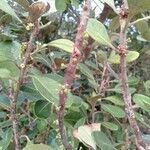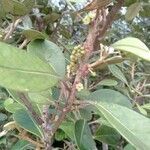Shrubs or trees, to 40 m tall but usually shorter. Bark brown. Branchlets angulate, rust colored sericeous to tomentose when young, glabrescent. Leaves scattered; petiole 0.5--5 cm; leaf blade obovate to lanceolate, 6--24 X 1.5--15 cm, membranous, papery, or leathery, abaxially rust colored, blackish tomentose, or sericeous but glabrescent, adaxially shining and glabrous, base narrowly to broadly cuneate, apex rounded to acuminate, lateral veins 7--18 pairs. Flowers female or bisexual, green to white, several in axillary clusters, 5-or 6-merous. Pedicels 2--10 mm, rust colored and white tomentose. Sepals 5(or 6), rounded or broadly ovate, 2--3 X 2--3 mm, outside white, yellow, or rust colored tomentose, inside glabrous, margin membranous, ciliate, or fimbriate. Corolla campanulate, 3--5 mm; lobes 5, broadly ovate to oblong. Stamens 2.5--3.5 mm, sometimes absent or abortive; staminodes lanceolate to triangular, sometimes absent. Ovary conical to obovoid, rust colored hirsute, 5--10-locular. Style conical, 1.5--2 mm, 5-ribbed. Fruit white, yellow, red, or blue when fresh, obovoid to globose, 1--1.5 X 1--1.5 cm; pericarp membranous, glabrous; 1--5-seeded. Seeds oblique fusiform, 8--12 X 2--3.5 mm, yellow; scar narrowly elliptic. Fr. Oct-Dec.
More
Shrubs or trees which can be up to 40 m tall. The trunk is 50 cm across. The trunk is crooked. It has buttresses. The bark is brown. The small branches are angular. They have rust coloured hairs when young. The leaves are scattered along the twigs. The leaf stalk is 0.5-5 cm long. The leaf blade is oval to sword shaped and 6-24 cm long by 1.5-15 cm wide. They are membranous, papery, or leathery. There are 5-13 pairs of secondary veins. The leaves are rust coloured and hairy on one side and smooth and shiny on the other. Several flowers (1-20) occur on clusters in the axils of leaves. They can be female or of both sexes. The flower petals are 2-3 mm long. They are white to greenish. The fruit are white, yellow, red or blue when fresh. They are round to oval and about 1.5 cm across. It is smooth and with yellow sweet flesh. There are 1-5 seeds inside. The seeds are long and 8-12 mm long by 2-3.5 mm across. They are yellow with a narrow scar.
A tropical plant. They grow in thickets at low elevations. It occurs in wet tropical forests. It can grow in cooler conditions. It can grow in poor soil conditions. It grows on rocky and sandy coasts on the landward side of mangroves. In Indonesia it can grow in lowland forest up to 400 m altitude. In the Andes it grows from sea level to 2,700 m altitude.
More
Wild shores: natural cliffs, rocky and sandy shores as well as secondary forests. In the wild, it originally also grew in the back mangroves.


